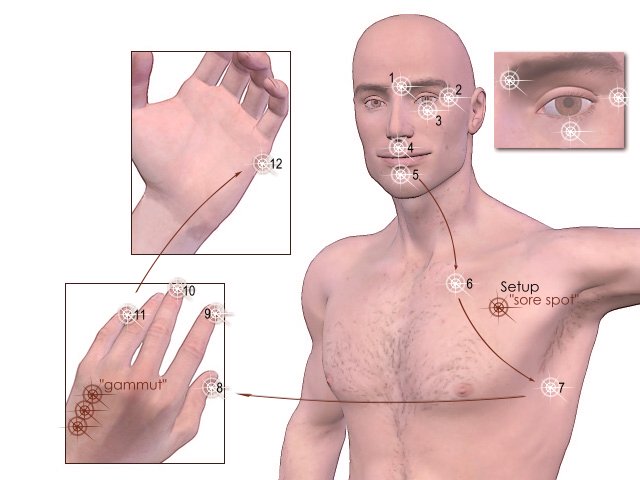EFT – Psychological Reversal
EFT Part I introduced you to The Setup as a label for the more technical phenomenon known as Psychological Reversal (a term coined by Dr. Roger Callahan but originally brought to the public by Dr. John Diamond). This is a fascinating discovery on its own and deserves special treatment in this course. Did you ever wonder why athletes get into slumps?
This defies normal logic. There is no physical reason for them to perform so far below par. The athlete is the same highly trained person before, after and during the slump. But all athletes go through this many times in their careers. Why?
….addictions are so hard to overcome?
After all, the addict usually wants to be free of their destructive patterns. They know, and will often admit, that their addiction is costing them their health, their relationships and even their life! Yet they continue with it. Why?
….depression is so hard to correct?
It is one of the most difficult psychological issues to handle. If one goes for conventional therapy to get over depression they are usually in for years of expensive procedures. And progress, if any is made, is usually accomplished in baby steps. Why?
….we sometimes self-sabotage ourselves?
When we try, for example, to lose weight or read faster we often manage to “stop ourselves” and fall back into our previous “comfort zones” with little or no real progress. Why?
….healing sometimes takes so long?
The lingering cold that just won’t go away, the sprain or broken bone that takes forever to heal, the headache or pain that stays and stays. Sometimes things just don’t heal normally. Why?
The reason is in the body’s energy system. It is the actual cause of what is commonly called self sabotage. It is the reason why we sometimes seem to be our own worst enemy and don’t reach those “new levels” we truly want. In addition to the above examples, it is also why people often try in vain to make more money and fall short in countless other pursuits even though they know they have the ability to achieve them. It is also a contributor to psychological blocks (like “writer’s block”) and learning limitations (like dyslexia).
Before this discovery, people’s seeming inability to make progress in areas that are obviously important to them was blamed on such things as “lack of will power”, “poor motivation”, “spacing out” or other forms of supposed character defects. But this isn’t so. There is another cause….and it is correctable.
Psychological Reversal (PR for short) is that cause.
It is an immensely important and practical discovery that is finding its way into several disciplines. It is vital in psychology, medicine, addictions, weight loss, and countless fields of endeavor including sports and business performance. Where PR is present, little or no headway will be made. It… literally blocks progress.
What is Psychological Reversal? Everyone experiences it. It occurs when the energy system in the body changes polarity and it usually happens outside your awareness. You don’t ordinarily “feel” it happening. It is a literal polarity reversal in your body’s energy system and is like having your “batteries in backwards” as explained in EFT Part I.
Interestingly, it often takes the form of what psychologists call “secondary gain or loss.” For example, the person who consciously believes that they want to lost weight will often have an unconscious “stopper” such as, “If I lose weight I will only gain it back again and that will cost me a lot of money in changing my wardrobe.” This person is psychologically reversed against losing weight.
How was PR discovered? Psychological Reversal has its roots in a field known as Applied Kinesiology. One of the tools of this discipline is known as muscle testing. Here the patient rigidly extends an arm straight out from the side of his or her body while the doctor pushes down on it to assess the patient’s strength. The doctor then has a dialogue with the patient and pushes down on the arm as the patient makes statements. If there is a subconscious disagreement with the statement, the muscles go weak and the arm is easily pushed down. Otherwise, the arm remains strong. This allows the doctor to “talk to the body” and thus help diagnose where problems might reside.
Dr. Roger Callahan was using this procedure with a lady who wanted to lose weight. For perspective, here is how he tells it in his book, “How Executives Overcome the Fear of Public Speaking and Other Phobias.”
“There is not a therapist practicing who has not encountered a patient who simply cannot be cured, no matter how effective the therapy ordinarily is or how diligently the patient and therapist apply themselves to the task. This resistance to treatment is a frustration to therapists and a trial to their patients. It has been called by many names, such as: death instinct, the loser syndrome, self-defeating behavior or negativity. These troubled patients are called by many names:
recalcitrant patients, negative personalities, self destructive individuals — but their situation is always much the same, they seem to resist all help — no matter what approach is used. They claim they want to be cured — but they do not respond to treatment.
While I was working with an overweight woman who professed to want to be thin, I encountered this negative block. She had been dieting with little success for years. Yet, in spite of her failure to cut down on eating, she insisted that she wanted to lose weight.
Using the muscle test, I asked her to picture herself thin, the way she said she wished to be. The result startled me. When she succeeded in picturing herself minus her extra weight, her arm tested weak. We were both surprised. Yet, in spite of the negative results, she insisted that she did want to lose weight. So I tried a different approach. I asked her to picture herself 30 pounds heavier than she was. Now she tested strong.
I restated the question even more directly. I had her say aloud, ‘I want to lose weight.’ The test suggested that her statement was not true. Now I had her say, ‘I want to gain weight.’ This time she tested strong. Obviously, there was a discrepancy between what she said she wanted and what the test indicated she wanted.
Curious, I tried this same test on six other clients who had been dieting for months or years without success. They all showed the same pattern. What they said they wanted was the reverse of what they were shown to want when I tested them using the same muscle test.
This was, certainly, not the first time I had encountered resistance to treatment. But now I had a tool with which to identify it and possibly overcome it.
To have the name of this condition also be a description of it, I called it Psychological Reversal. ….Now I began to test all my other clients with reference to their major problems (ie: ‘I want to get over my anxiety attacks,’ ‘I want to get a better relationship with my wife/husband/lover,’ ‘I want to overcome my frigidity/impotence/premature ejaculation,’ or ‘I want to be a successful and/or fine actor/singer/musician/composer,’ etc.). In each case, I also had the patient make a reverse statement (ie: ‘I do not want to get over my anxiety attacks,’ etc.). And each time I tested, using the arm test.
I was flabbergasted at the results of these tests. I found to my chagrin that a large number of my clients got weak when they thought of getting better and stronger when they thought of getting worse.
No wonder psychotherapy is so difficult….”
What causes PR? The principle cause is negative thinking. Even the most positive thinkers among us carry around subconscious negative, self defeating thoughts. PR is the usual result. As a general rule, the more pervasive this type of thinking, the more prone we are to becoming psychologically reversed.
With some people it is an all pervasive phenomenon. It stops them just about everywhere they go. You can usually tell who these people are because nothing ever seems to work for them. They complain a lot and consider themselves a victim of the world. People with this “across the board” form of reversal are called massively reversed.
PR is also a chronic companion of those who suffer from depression. Depression, negative thinking and PR live in the same house.
Please understand, PR is not a character defect. These people, unknowingly, suffer from a chronic reversal of the electrical polarity in their bodies. Their energy systems literally work against them. As a result, they are stymied just about everywhere they go. It is not the world that is against them….it is their own energy system. Their batteries are in backwards. Most people know, at least intuitively, that negative thinking blocks their progress. That’s why there are so many books and seminars on positive thinking.
However, up until now, no one has been able to explain how negative thinking creates these blocks much less provide a way to correct it. Psychological Reversal does both.
With most people PR shows up in specific areas. A person may do very well in many areas in their life but giving up cigarettes, for example, seems to be out of their reach. They may consciously want to quit and may want to do so badly. In fact, they may even give the habit up for awhile. But eventually, if they are PR, they will sabotage their own efforts and start smoking again. They aren’t weak. They are PR.
The energy in our bodies must flow properly if we are to perform up to our potential. Psychological Reversal is one of the important ways in which it becomes interrupted. PR is also correctable and the correction, which is called The Setup in EFT, only takes a few seconds to do. This process is covered in detail as part of The Basic Recipe.
PR is possible in any human endeavor. There are literally thousands of possibilities. But just to illustrate, here are a few examples.


Some examples of Psychological Reversal
Learning difficulties. Writer’s block and most learning difficulties are often a direct result of PR. A student, for instance, can do well in all subjects except one (like chemistry) and the odds are high that PR is behind the poor subject.
Students don’t know they are psychologically reversed because, until now, they didn’t even know the phenomenon existed. But they do tend to give reasons for their “inadequacy.” They may say, “I’ m just not cut out for chemistry,” or “I can’t seem to concentrate on it,” or “I hate it.”
These reasons are usually inaccurate. The real reason is usually PR. When they think about their poor subject, their polarity reverses and performance suffers accordingly. Correct the PR and the grades will usually improve.
Some students are PR about school in general. This is a major contributor to poor grades and it often goes unaddressed. The students are considered “slow” or “learning disabled.” What a label to carry through life unnecessarily!
Health. PR is almost always present with degenerative diseases such as cancer, AIDS, multiple sclerosis, fibromyalgia, lupus, arthritis, diabetes, etc.
From an EFT point of view, it is one of the main impediments to healing. In time, I suspect western medical disciplines will recognize this fact and integrate PR into their other techniques. Unreversing oneself (aiming The Setup at a particular ailment) appears to allow the body’s natural healing processes to work more fluidly. This makes sense when you consider the importance of the proper flow of energy throughout the body. Broken bones seem to heal more quickly when your “batteries are installed properly” and physical ailments of many kinds make greater progress.
Physicians, acupuncturists, chiropractors and other health practitioners whose patients are making unsatisfactory progress might wish to teach their patients to unreverse themselves. It may release more healing force and speed up the recovery.
Athletics. It’s a good bet that people are PR whenever they are stymied in some area of progress in their life. Athletes are prime examples of this. The great basketball player who is lousy on the free throw line is almost certainly PR about shooting free throws.
Correcting for the reversal will likely bring about a dramatic improvement. The same goes for field goal kickers, high jumpers, baseball hitters and athletes of all types. Owners and coaches of professional sports teams could make stunning use of this easy concept.
Dyslexia. If you think about it, dyslexia is a classic example of reversal. In fact, reversal is its major symptom. Among other things, people transpose numbers and letters and thus have difficulty learning. Annie approached me after one of my seminars and asked me if I could help her with the dyslexia she had lived with since childhood. She was 49 years old. She told me she couldn’t write down telephone numbers accurately. “I get the first 3 numbers right”, she said, “but I mess up the last 4.”
I then recited 10 telephone numbers to her and asked her to write them down. Sure enough. All 10 were wrong. I helped her correct her PR and then recited 10 more phone numbers. This time she got 9 of them perfect ….and it was effortless.
I don’t want to leave the wrong impression. We may not have totally eliminated her dyslexia. What happened was that we got her Psychological Reversal temporarily out of the way and, with it gone, she performed normally. That is a stunning example of the power of PR. In the case of dyslexia, the PR will likely reappear in time and with it will come the dysfunction.
Annie has more to do. But without an understanding of PR, her progress will most likely be very slow if, indeed, there is any progress at all.
PR blocks progress. Of particular importance with EFT is that… when PR is present the tapping procedure won’t work. Remember, PR literally blocks progress and that is just as true with EFT as it is with any other technique.
I have many friends who are psychotherapists and they all have numerous clients that just don’t respond to even the best of techniques. Until they learned of Psychological Reversal, this blockage was a mystery to them.
After years of experience with EFT we now know how often PR shows up. PR is present in about 40% of the issues that people address with EFT. In some issues, however, PR is almost always blocking progress. Depression, addictions and degenerative diseases are the main examples. For most issues, however, PR may or may not be present in a given individual. One person may be PR for relieving asthma, for example, and another may not.
How will you know if you are experiencing PR? You won’t. That’s why The Basic Recipe includes an automatic correction for it (The Setup). It only takes seconds to perform and does no harm to correct it even if it isn’t there. So, unless PR is corrected, your success ratio with these methods will suffer dramatically.
That’s why the correction for PR is built into The Basic Recipe.
Source:





